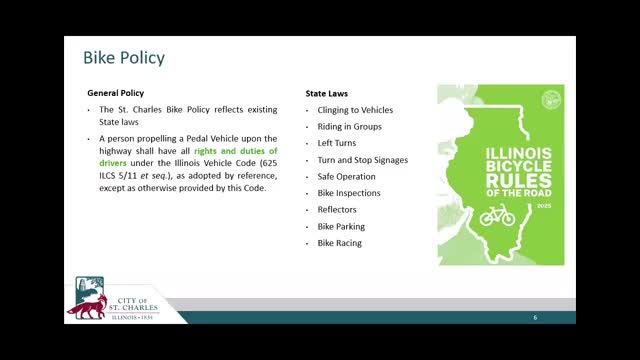Bridal Illinois Council Updates Bicycle Policy for Safety and Compliance
September 16, 2025 | Saint Charles City, St. Charles County, Illinois
This article was created by AI summarizing key points discussed. AI makes mistakes, so for full details and context, please refer to the video of the full meeting. Please report any errors so we can fix them. Report an error »

Bicycle regulations took center stage at the Saint Charles Government Operations Committee meeting on September 15, 2025, as officials discussed new policies aimed at enhancing safety and compliance for cyclists and other micro-mobility users. The proposed policy aligns closely with existing Illinois state laws, emphasizing that while bicycles have the right to use the road, they must also adhere to the Illinois vehicle code.
One of the key recommendations is that non-motorized bicycles will be allowed to ride on sidewalks, except in the downtown area, where safety concerns for pedestrians are paramount. In this heavily trafficked zone, cyclists must either use designated bike lanes or dismount and walk their bikes. This decision aims to reduce potential conflicts between cyclists and pedestrians in crowded spaces.
The discussion also highlighted specific regulations for various types of bicycles and micro-mobility devices. For instance, low-speed electric scooters, typically used by children, can ride on sidewalks, while higher-speed electric scooters and e-bikes must remain on roads and bike lanes. Notably, riders of Class 3 e-bikes must be at least 16 years old, and those using high-speed electric scooters must be 18 and possess a valid driver's license.
To address community concerns, the policy includes an escalating penalty structure for violations, starting at $25 for first offenses and increasing for repeat offenders. Additionally, all micro-mobility devices will be required to have bells to alert pedestrians of their approach, a measure aimed at improving safety.
The committee also discussed the need for better signage in downtown areas to inform cyclists of the regulations, as many residents are unaware of the rules governing bike usage. Plans for educational outreach, including brochures and a dedicated website, are in the works to ensure that the community is well-informed about the new policies.
As the city prepares to implement these changes, officials anticipate ongoing updates to the regulations to adapt to new devices and state laws, ensuring that safety remains a top priority for all road users.
One of the key recommendations is that non-motorized bicycles will be allowed to ride on sidewalks, except in the downtown area, where safety concerns for pedestrians are paramount. In this heavily trafficked zone, cyclists must either use designated bike lanes or dismount and walk their bikes. This decision aims to reduce potential conflicts between cyclists and pedestrians in crowded spaces.
The discussion also highlighted specific regulations for various types of bicycles and micro-mobility devices. For instance, low-speed electric scooters, typically used by children, can ride on sidewalks, while higher-speed electric scooters and e-bikes must remain on roads and bike lanes. Notably, riders of Class 3 e-bikes must be at least 16 years old, and those using high-speed electric scooters must be 18 and possess a valid driver's license.
To address community concerns, the policy includes an escalating penalty structure for violations, starting at $25 for first offenses and increasing for repeat offenders. Additionally, all micro-mobility devices will be required to have bells to alert pedestrians of their approach, a measure aimed at improving safety.
The committee also discussed the need for better signage in downtown areas to inform cyclists of the regulations, as many residents are unaware of the rules governing bike usage. Plans for educational outreach, including brochures and a dedicated website, are in the works to ensure that the community is well-informed about the new policies.
As the city prepares to implement these changes, officials anticipate ongoing updates to the regulations to adapt to new devices and state laws, ensuring that safety remains a top priority for all road users.
View full meeting
This article is based on a recent meeting—watch the full video and explore the complete transcript for deeper insights into the discussion.
View full meeting
